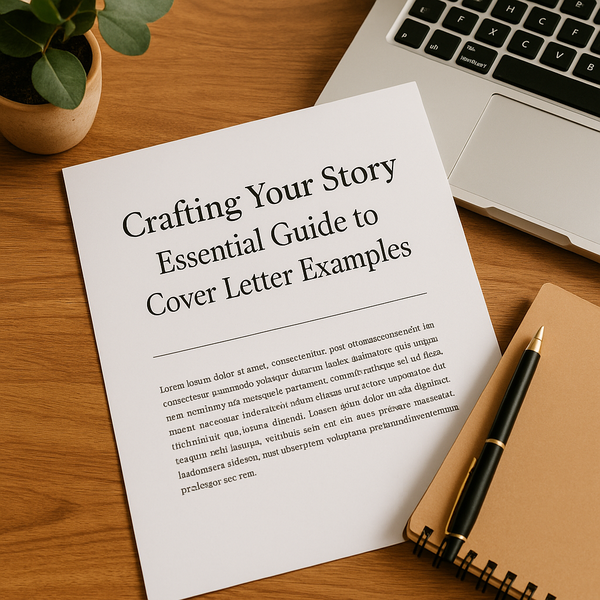
A cover letter is often your first direct communication with a potential employer. It's more than just a formality; it's your opportunity to make a strong first impression, showcase your personality, and explain how your skills and experience align specifically with the job description. Think of it as a personal introduction that complements your resume, allowing you to elaborate on key achievements and express genuine interest in the position and the company.
What is a Cover Letter?
A cover letter is a formal document submitted with your resume when applying for a job. Its primary purpose is to introduce yourself to the hiring manager, express your interest in the specific role, and briefly highlight your most relevant qualifications. Unlike a resume, which is a factual summary of your work history and skills, a cover letter allows you to tell a brief story, explain gaps in employment, or provide context for your career trajectory. It demonstrates your written communication skills and attention to detail.
Why Are Cover Letters Important?
In today's competitive job market, a compelling cover letter can set you apart from other candidates. Many employers still view cover letters as a crucial part of the application process. They offer insights into your motivation, enthusiasm, and ability to articulate your value proposition. A well-written cover letter shows you've done your research about the company and the role, demonstrating a genuine interest that goes beyond simply applying for any open position. It's your chance to connect the dots between your background and the specific requirements of the job.
Types of Cover Letters
While the core purpose remains consistent, cover letters can vary depending on the situation:
- Application Letters: The most common type, sent when formally applying for an advertised position.
- Prospecting Letters: Sent to companies even when no specific position is advertised, expressing interest and inquiring about potential opportunities.
- Networking Letters: Used when following up after a networking event or informational interview.
- Referral Letters: Mentioning a mutual contact who referred you to the position or company.
Each type requires a slightly different approach and focus, but all aim to make a positive impression and move your application forward.
Key Components of an Effective Cover Letter
A standard cover letter typically includes several essential parts:
Contact Information
Your contact information (full name, address, phone number, email) and the date, followed by the recipient's contact information (hiring manager's name, title, company name, address). Ensure this is accurate and professionally formatted.
Salutation
Address the hiring manager directly by name if possible. Doing research to find the correct contact person shows initiative. If the name is unavailable, use a professional general salutation like "Dear Hiring Manager" or "Dear [Department Name] Team".
Introduction
State the position you are applying for and where you saw the advertisement (if applicable). Briefly mention your enthusiasm for the role and the company. This paragraph should immediately grab the reader's attention.
Body Paragraphs
This is where you elaborate on your most relevant skills, experiences, and achievements. Connect your qualifications directly to the requirements listed in the job description. Use specific examples and quantify your accomplishments whenever possible. Avoid simply restating your resume; instead, provide context and explain *why* your experience makes you a strong candidate. You might dedicate separate paragraphs to different key qualifications or experiences.
Conclusion
Reiterate your interest in the position and briefly summarize why you are a good fit. Express your availability for an interview and thank the reader for their time and consideration. This paragraph should reinforce your key message.
Closing
Use a professional closing such as "Sincerely," or "Respectfully,". Leave space for your handwritten signature (if sending a physical copy) and type your full name below.
Tips for Writing a Winning Cover Letter
- Tailor Each Letter: Never use a generic cover letter. Customize each letter for the specific job and company. Mention specific details about the role or company that resonate with you.
- Use Keywords: Incorporate keywords from the job description into your cover letter. This is crucial for getting past Applicant Tracking Systems (ATS).
- Highlight Achievements, Not Just Duties: Instead of listing past job duties, focus on what you accomplished in those roles. Use action verbs and quantifiable results.
- Keep it Concise: Aim for one page, ideally three to four paragraphs. Hiring managers are busy and appreciate brevity and clarity.
- Maintain a Professional Tone: Use formal language and avoid slang or casual expressions.
- Proofread Meticulously: Typos and grammatical errors can quickly sink your application. Read your letter carefully, and ask someone else to review it for errors.
- Match Your Resume: Ensure the information in your cover letter aligns with your resume.
- Research the Company: Show you understand the company's mission, values, or recent work. Mentioning specific projects or achievements of the company can impress the reader.
Creating a compelling cover letter takes time and effort, but it's an investment in your job search. It's your voice in the application process, providing a personal touch that a resume alone cannot. By following these guidelines and reviewing cover letter examples, you can significantly improve your chances of landing an interview.
In conclusion, mastering the art of writing a cover letter is an essential skill for any job seeker. It serves as a powerful tool to express your interest, highlight your most relevant qualifications, and make a memorable impression on potential employers. By tailoring your letter to each specific application and focusing on demonstrating your value, you can create a document that effectively complements your resume and opens the door to new career opportunities. Start exploring different cover letter examples and find the style that best showcases your professional story.

